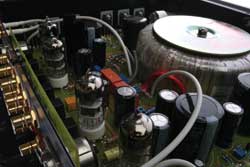 |
|||||||
| |
|
|
|
 |
|
|
|
Appearance This amp comes dressed in a simple but handsome case featuring an 8mm aluminum faceplate, with push buttons for selection of input and power, and a large rotary volume control. All the controls exude quality, as does the unusually shaped and very heavy aluminum remote control. The inputs include one balanced, three unbalanced and a tape loop. There are no other controls, not even balance, except for a mute button on the remote control. The rear panel connectors appear substantial and well spaced, with the exception of the binding posts, which are narrow and rather hard to grip. The Sound For this review the Predator joins a reference system comprising Nordost Valhalla cabling (reviewed in Vol. 13, No.2) and Thor power distribution unit (reviewed in Vol. 16, No 4), an EMM Labs CDSA SE digital source (reviewed in the last issue) and modified Wilson Benesch Act 1 speakers — a very transparent and evenly balanced system capable of dramatic dynamics with the right amplification. The Predator replaces a Perreaux Radiance R200i (reviewed in Vol. 16, No.2) and another 200 wpc integrated amp from far, far away, this time New Zealand. You might suppose the US $3,000 Predator would be quite out of its depth in this system, but the idea is to match it with a set of high resolution components and cables to see just how fine a job it can do. For these tests I used both the unbalanced and balanced inputs, with a slight preference for the balanced. The Predator, already well run in, is a pleasure to use. The controls are simple and silky in operation, and the amp presents no extraneous noises when switching between sources. True to form, it strikes a balance between the sound of tube and transistor-driven amplifiers. You have the wide bandwidth of a silicon-based component, but with none of the brittle or hard edge that is sometimes evident. However, while it does a good job on detail retrieval and tonal color, it falls short of the Perreaux in dynamic range and image depth. The bass is full and warm but lacks the visceral edge of the best amplifiers, losing out in rhythmic vitality. Distortion is commendably low, and you can turn up the volume to satisfying levels without noticeable compression.
Synopsis and Commentary The ideal amplifier excels with all types of music. It never editorializes or adds warmth or transient snap to the audio signal, but does justice to the recorded signal through accuracy, resolution, imaging, coherence and dynamics. Clearly the Valve Audio Predator does not come as close to the ideal as the much more expensive Perreaux, and it is much more comfortable in some roles than others. This is not a universal amp and you must examine your own musical tastes to see if they coincide with the areas in which the Predator excels. Can you do better at this price? In some ways you can. There are more open amps around, with exceptional dynamic qualities, such as the Creek Destiny (US $2,395) or the Bryston B100 SST (US $2,995). However, both of these are less powerful at 100wpc than the Predator’s 200wpc. To comfortably exceed the performance of the Predator you can look to the more expensive Edge G6, which runs US $4,691 and outputs 135wpc. The toughest competitor may well be the Krell KAV-400xi (US $2,500) which matches the Predator’s output into 8 ohms and combines high resolution with a ruler flat response and tight control down to the deep bass. If you’re interested in hybrid amps, you should also consider the Unison Research Unico SE (US$3,150) with its 140wpc output. This amp combines excellent all-round performance with a rather more modern look than the Predator and may be its closest sonic competitor. Of these alternatives, the Edge and the Unico come closest to the expressiveness and musicality that are the Predator’s forte. You can also look at separates but once you’ve paid for the extra power cord and interconnects, the financial advantage is usually with the integrated amp. You also have the possibility of less than ideal impedance and level matching between components, so the integrated wins most of the time in my book. We are long past the days when integrated amps were looked down upon by most serious audiophiles. There has been an explosion in the number of attempts at statement integrated amps, from the Jeff Rowland Concentra to the ASR Emitter amp. I feel the same way about transports and DACs. Give me an integrated CD player any day. The argument is less compelling at the extreme high-end, but that’s a topic for another day. This is the first South African component I’ve had in my system and it has never embarrassed itself. I’ve enjoyed my time with the Predator and believe it offers good value for the money. I recommend you take the time to search out and audition the Predator if you are looking for a simple high-quality remote-controlled integrated amp in this price range.
|
|
|||||||||||||||||||||||||||||||
| News | Reviews | Commentary | Marketplace | Contact Us | Home |

